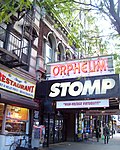Burp Castle
1992 establishments in New York CityBeer in New York CityEast Village, ManhattanNew York City restaurant stubsRestaurants in Manhattan

Burp Castle is a beer bar located in the East Village neighborhood of Manhattan in New York City. It is ostensibly "monastery-themed". Bartenders occasionally wear monastic robes, play Gregorian chants, and patrons are shushed if they speak above a whisper. The bar is located near the site of the 2015 East Village gas explosion, and it was forced to close for several weeks before occupancy was proved to once again be safe.SoundPrint, an app that measures noise produced in restaurants and bars, lists Burp Castle as a particularly quiet location.
Excerpt from the Wikipedia article Burp Castle (License: CC BY-SA 3.0, Authors, Images).Burp Castle
East 7th Street, New York Manhattan
Geographical coordinates (GPS) Address Nearby Places Show on map
Geographical coordinates (GPS)
| Latitude | Longitude |
|---|---|
| N 40.728372222222 ° | E -73.988580555556 ° |
Address
East 7th Street 43
10003 New York, Manhattan
New York, United States
Open on Google Maps







